Vestas Marketing Context Evaluation & Key Marketing Strategies
VerifiedAdded on 2022/11/24
|12
|4088
|220
AI Summary
This document provides an analysis of the strategic marketing context for Vestas, a global partner in the wind energy industry. It includes an evaluation of key contextual factors, customer analysis, and an analysis of the company's marketing resources and capabilities. The document also discusses the determination and evaluation of critical strategic marketing approaches for Vestas.
Contribute Materials
Your contribution can guide someone’s learning journey. Share your
documents today.
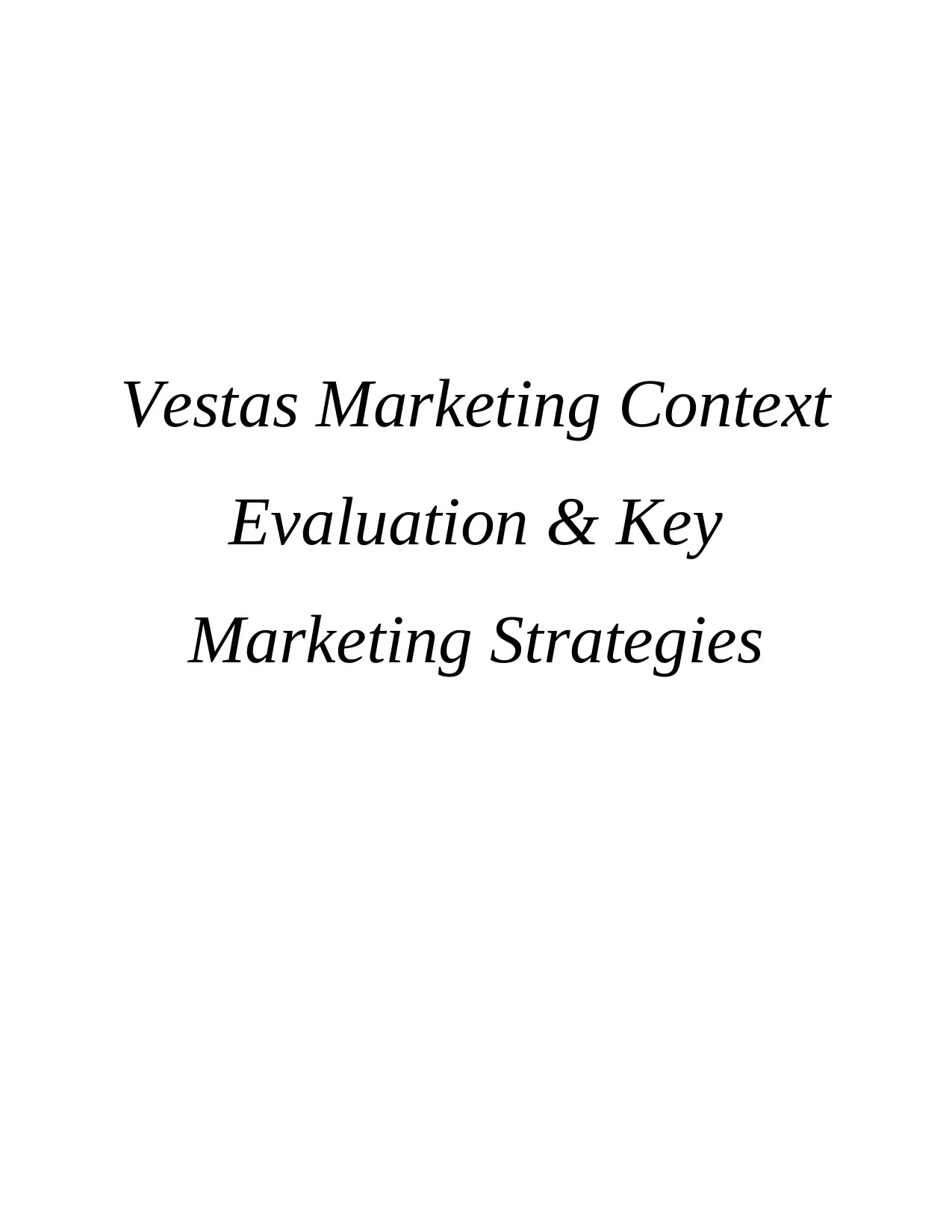
Vestas Marketing Context
Evaluation & Key
Marketing Strategies
Evaluation & Key
Marketing Strategies
Secure Best Marks with AI Grader
Need help grading? Try our AI Grader for instant feedback on your assignments.
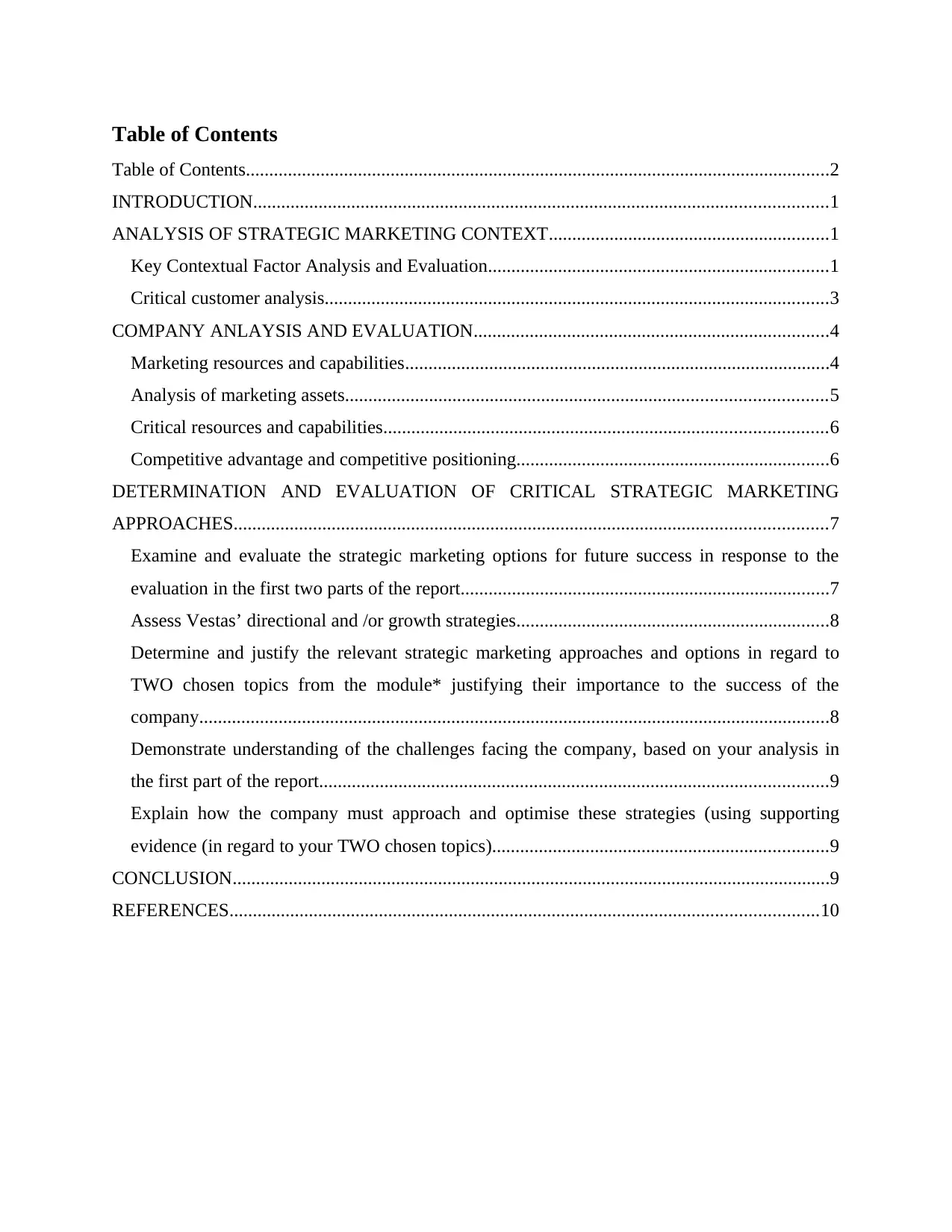
Table of Contents
Table of Contents.............................................................................................................................2
INTRODUCTION...........................................................................................................................1
ANALYSIS OF STRATEGIC MARKETING CONTEXT............................................................1
Key Contextual Factor Analysis and Evaluation.........................................................................1
Critical customer analysis............................................................................................................3
COMPANY ANLAYSIS AND EVALUATION............................................................................4
Marketing resources and capabilities...........................................................................................4
Analysis of marketing assets.......................................................................................................5
Critical resources and capabilities...............................................................................................6
Competitive advantage and competitive positioning...................................................................6
DETERMINATION AND EVALUATION OF CRITICAL STRATEGIC MARKETING
APPROACHES...............................................................................................................................7
Examine and evaluate the strategic marketing options for future success in response to the
evaluation in the first two parts of the report...............................................................................7
Assess Vestas’ directional and /or growth strategies...................................................................8
Determine and justify the relevant strategic marketing approaches and options in regard to
TWO chosen topics from the module* justifying their importance to the success of the
company.......................................................................................................................................8
Demonstrate understanding of the challenges facing the company, based on your analysis in
the first part of the report.............................................................................................................9
Explain how the company must approach and optimise these strategies (using supporting
evidence (in regard to your TWO chosen topics)........................................................................9
CONCLUSION................................................................................................................................9
REFERENCES..............................................................................................................................10
Table of Contents.............................................................................................................................2
INTRODUCTION...........................................................................................................................1
ANALYSIS OF STRATEGIC MARKETING CONTEXT............................................................1
Key Contextual Factor Analysis and Evaluation.........................................................................1
Critical customer analysis............................................................................................................3
COMPANY ANLAYSIS AND EVALUATION............................................................................4
Marketing resources and capabilities...........................................................................................4
Analysis of marketing assets.......................................................................................................5
Critical resources and capabilities...............................................................................................6
Competitive advantage and competitive positioning...................................................................6
DETERMINATION AND EVALUATION OF CRITICAL STRATEGIC MARKETING
APPROACHES...............................................................................................................................7
Examine and evaluate the strategic marketing options for future success in response to the
evaluation in the first two parts of the report...............................................................................7
Assess Vestas’ directional and /or growth strategies...................................................................8
Determine and justify the relevant strategic marketing approaches and options in regard to
TWO chosen topics from the module* justifying their importance to the success of the
company.......................................................................................................................................8
Demonstrate understanding of the challenges facing the company, based on your analysis in
the first part of the report.............................................................................................................9
Explain how the company must approach and optimise these strategies (using supporting
evidence (in regard to your TWO chosen topics)........................................................................9
CONCLUSION................................................................................................................................9
REFERENCES..............................................................................................................................10
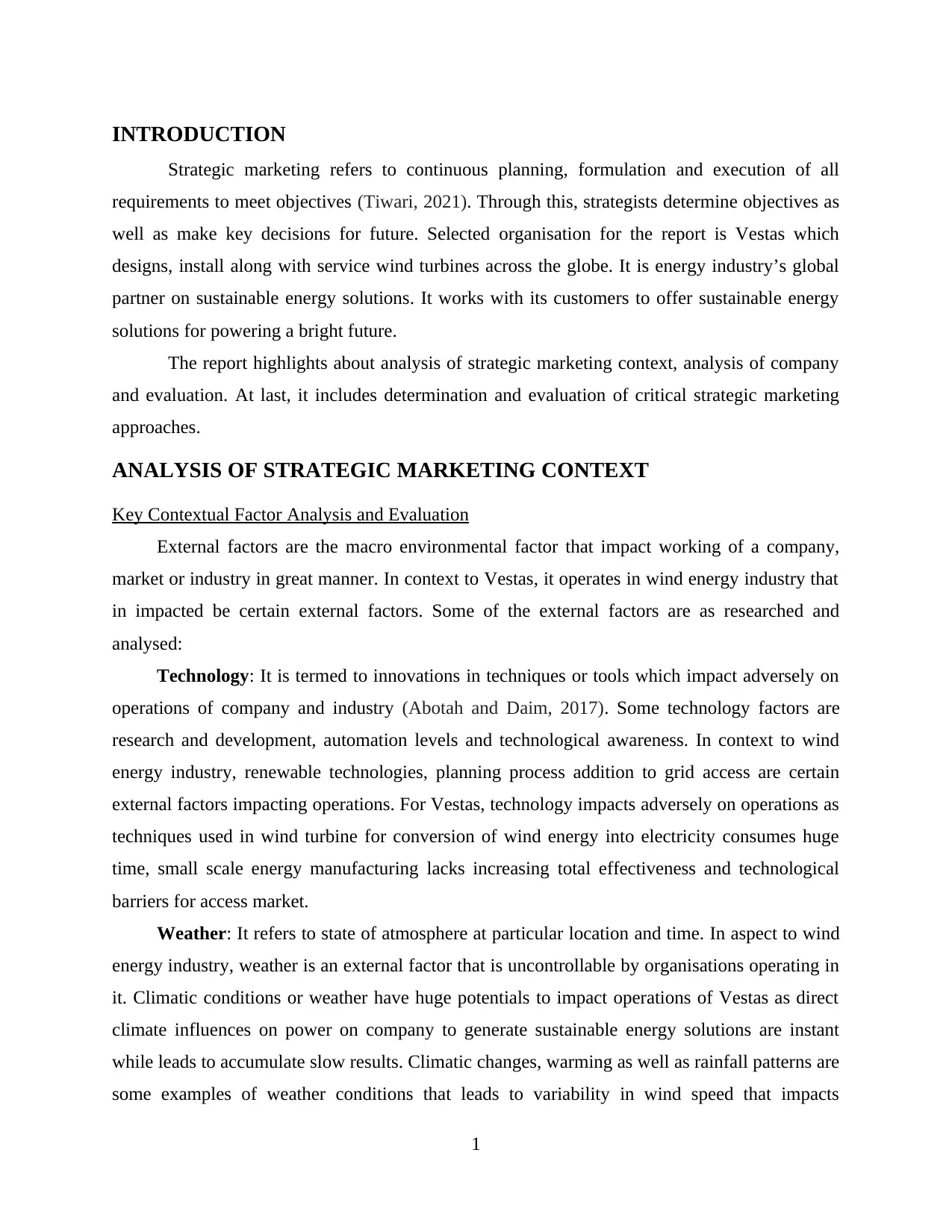
INTRODUCTION
Strategic marketing refers to continuous planning, formulation and execution of all
requirements to meet objectives (Tiwari, 2021). Through this, strategists determine objectives as
well as make key decisions for future. Selected organisation for the report is Vestas which
designs, install along with service wind turbines across the globe. It is energy industry’s global
partner on sustainable energy solutions. It works with its customers to offer sustainable energy
solutions for powering a bright future.
The report highlights about analysis of strategic marketing context, analysis of company
and evaluation. At last, it includes determination and evaluation of critical strategic marketing
approaches.
ANALYSIS OF STRATEGIC MARKETING CONTEXT
Key Contextual Factor Analysis and Evaluation
External factors are the macro environmental factor that impact working of a company,
market or industry in great manner. In context to Vestas, it operates in wind energy industry that
in impacted be certain external factors. Some of the external factors are as researched and
analysed:
Technology: It is termed to innovations in techniques or tools which impact adversely on
operations of company and industry (Abotah and Daim, 2017). Some technology factors are
research and development, automation levels and technological awareness. In context to wind
energy industry, renewable technologies, planning process addition to grid access are certain
external factors impacting operations. For Vestas, technology impacts adversely on operations as
techniques used in wind turbine for conversion of wind energy into electricity consumes huge
time, small scale energy manufacturing lacks increasing total effectiveness and technological
barriers for access market.
Weather: It refers to state of atmosphere at particular location and time. In aspect to wind
energy industry, weather is an external factor that is uncontrollable by organisations operating in
it. Climatic conditions or weather have huge potentials to impact operations of Vestas as direct
climate influences on power on company to generate sustainable energy solutions are instant
while leads to accumulate slow results. Climatic changes, warming as well as rainfall patterns are
some examples of weather conditions that leads to variability in wind speed that impacts
1
Strategic marketing refers to continuous planning, formulation and execution of all
requirements to meet objectives (Tiwari, 2021). Through this, strategists determine objectives as
well as make key decisions for future. Selected organisation for the report is Vestas which
designs, install along with service wind turbines across the globe. It is energy industry’s global
partner on sustainable energy solutions. It works with its customers to offer sustainable energy
solutions for powering a bright future.
The report highlights about analysis of strategic marketing context, analysis of company
and evaluation. At last, it includes determination and evaluation of critical strategic marketing
approaches.
ANALYSIS OF STRATEGIC MARKETING CONTEXT
Key Contextual Factor Analysis and Evaluation
External factors are the macro environmental factor that impact working of a company,
market or industry in great manner. In context to Vestas, it operates in wind energy industry that
in impacted be certain external factors. Some of the external factors are as researched and
analysed:
Technology: It is termed to innovations in techniques or tools which impact adversely on
operations of company and industry (Abotah and Daim, 2017). Some technology factors are
research and development, automation levels and technological awareness. In context to wind
energy industry, renewable technologies, planning process addition to grid access are certain
external factors impacting operations. For Vestas, technology impacts adversely on operations as
techniques used in wind turbine for conversion of wind energy into electricity consumes huge
time, small scale energy manufacturing lacks increasing total effectiveness and technological
barriers for access market.
Weather: It refers to state of atmosphere at particular location and time. In aspect to wind
energy industry, weather is an external factor that is uncontrollable by organisations operating in
it. Climatic conditions or weather have huge potentials to impact operations of Vestas as direct
climate influences on power on company to generate sustainable energy solutions are instant
while leads to accumulate slow results. Climatic changes, warming as well as rainfall patterns are
some examples of weather conditions that leads to variability in wind speed that impacts
1
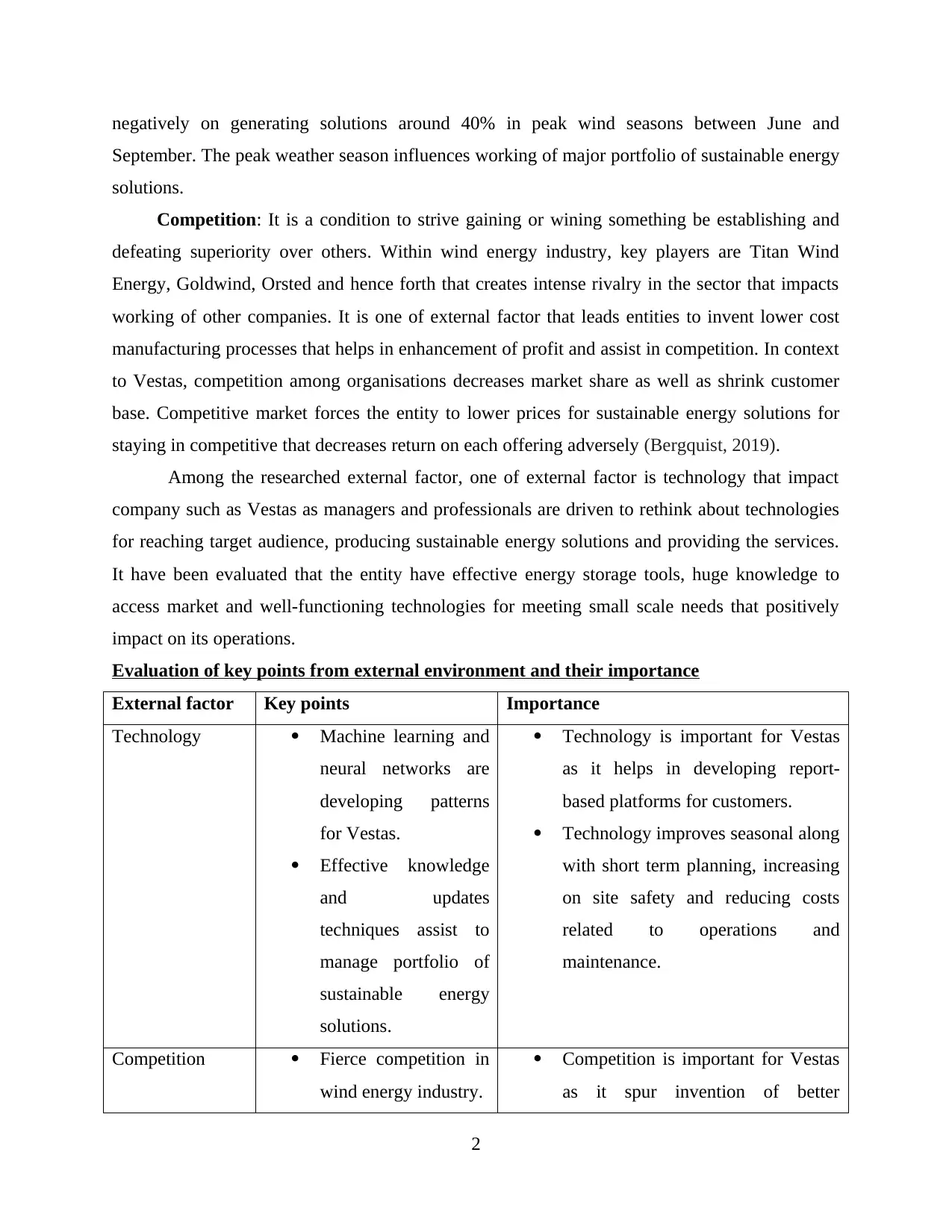
negatively on generating solutions around 40% in peak wind seasons between June and
September. The peak weather season influences working of major portfolio of sustainable energy
solutions.
Competition: It is a condition to strive gaining or wining something be establishing and
defeating superiority over others. Within wind energy industry, key players are Titan Wind
Energy, Goldwind, Orsted and hence forth that creates intense rivalry in the sector that impacts
working of other companies. It is one of external factor that leads entities to invent lower cost
manufacturing processes that helps in enhancement of profit and assist in competition. In context
to Vestas, competition among organisations decreases market share as well as shrink customer
base. Competitive market forces the entity to lower prices for sustainable energy solutions for
staying in competitive that decreases return on each offering adversely (Bergquist, 2019).
Among the researched external factor, one of external factor is technology that impact
company such as Vestas as managers and professionals are driven to rethink about technologies
for reaching target audience, producing sustainable energy solutions and providing the services.
It have been evaluated that the entity have effective energy storage tools, huge knowledge to
access market and well-functioning technologies for meeting small scale needs that positively
impact on its operations.
Evaluation of key points from external environment and their importance
External factor Key points Importance
Technology Machine learning and
neural networks are
developing patterns
for Vestas.
Effective knowledge
and updates
techniques assist to
manage portfolio of
sustainable energy
solutions.
Technology is important for Vestas
as it helps in developing report-
based platforms for customers.
Technology improves seasonal along
with short term planning, increasing
on site safety and reducing costs
related to operations and
maintenance.
Competition Fierce competition in
wind energy industry.
Competition is important for Vestas
as it spur invention of better
2
September. The peak weather season influences working of major portfolio of sustainable energy
solutions.
Competition: It is a condition to strive gaining or wining something be establishing and
defeating superiority over others. Within wind energy industry, key players are Titan Wind
Energy, Goldwind, Orsted and hence forth that creates intense rivalry in the sector that impacts
working of other companies. It is one of external factor that leads entities to invent lower cost
manufacturing processes that helps in enhancement of profit and assist in competition. In context
to Vestas, competition among organisations decreases market share as well as shrink customer
base. Competitive market forces the entity to lower prices for sustainable energy solutions for
staying in competitive that decreases return on each offering adversely (Bergquist, 2019).
Among the researched external factor, one of external factor is technology that impact
company such as Vestas as managers and professionals are driven to rethink about technologies
for reaching target audience, producing sustainable energy solutions and providing the services.
It have been evaluated that the entity have effective energy storage tools, huge knowledge to
access market and well-functioning technologies for meeting small scale needs that positively
impact on its operations.
Evaluation of key points from external environment and their importance
External factor Key points Importance
Technology Machine learning and
neural networks are
developing patterns
for Vestas.
Effective knowledge
and updates
techniques assist to
manage portfolio of
sustainable energy
solutions.
Technology is important for Vestas
as it helps in developing report-
based platforms for customers.
Technology improves seasonal along
with short term planning, increasing
on site safety and reducing costs
related to operations and
maintenance.
Competition Fierce competition in
wind energy industry.
Competition is important for Vestas
as it spur invention of better
2
Secure Best Marks with AI Grader
Need help grading? Try our AI Grader for instant feedback on your assignments.
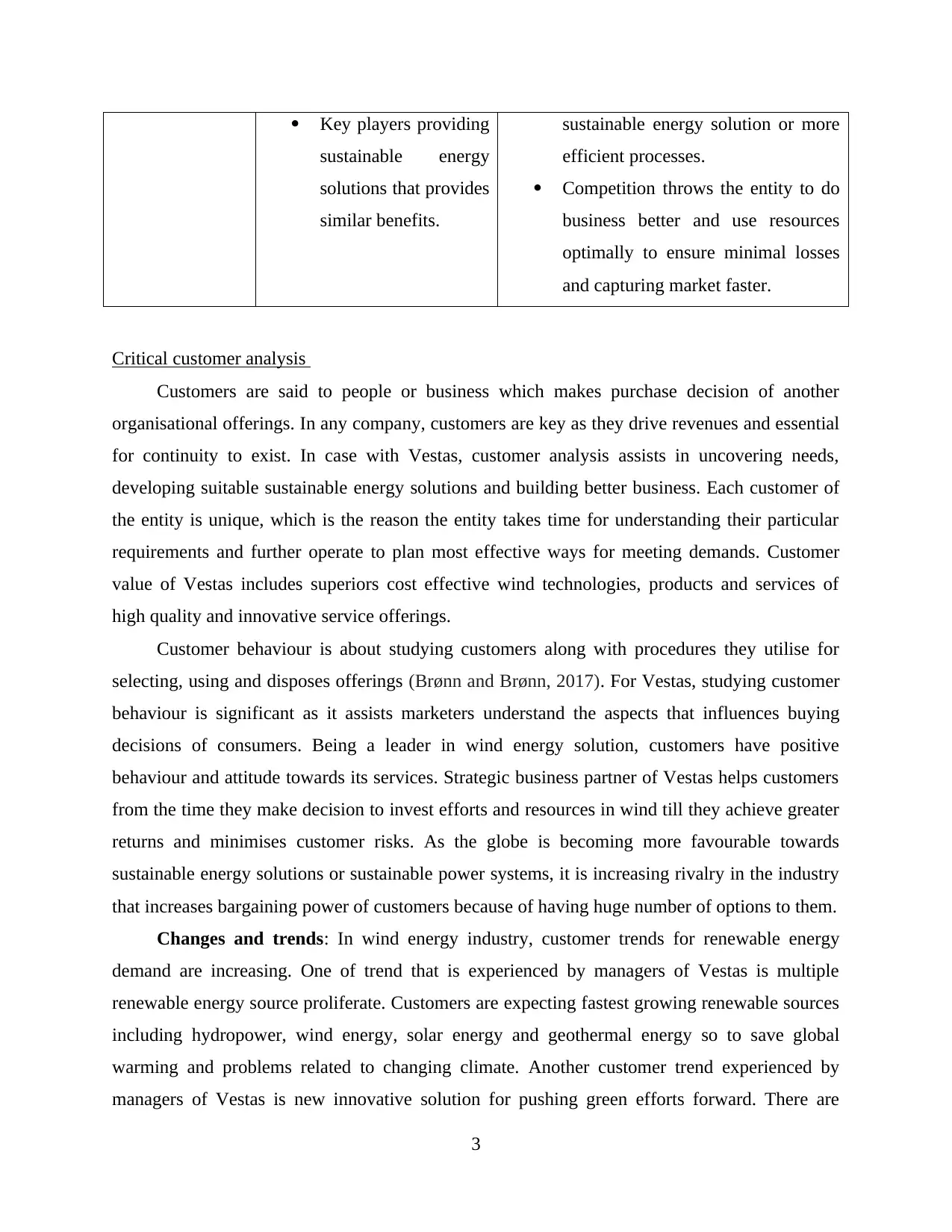
Key players providing
sustainable energy
solutions that provides
similar benefits.
sustainable energy solution or more
efficient processes.
Competition throws the entity to do
business better and use resources
optimally to ensure minimal losses
and capturing market faster.
Critical customer analysis
Customers are said to people or business which makes purchase decision of another
organisational offerings. In any company, customers are key as they drive revenues and essential
for continuity to exist. In case with Vestas, customer analysis assists in uncovering needs,
developing suitable sustainable energy solutions and building better business. Each customer of
the entity is unique, which is the reason the entity takes time for understanding their particular
requirements and further operate to plan most effective ways for meeting demands. Customer
value of Vestas includes superiors cost effective wind technologies, products and services of
high quality and innovative service offerings.
Customer behaviour is about studying customers along with procedures they utilise for
selecting, using and disposes offerings (Brønn and Brønn, 2017). For Vestas, studying customer
behaviour is significant as it assists marketers understand the aspects that influences buying
decisions of consumers. Being a leader in wind energy solution, customers have positive
behaviour and attitude towards its services. Strategic business partner of Vestas helps customers
from the time they make decision to invest efforts and resources in wind till they achieve greater
returns and minimises customer risks. As the globe is becoming more favourable towards
sustainable energy solutions or sustainable power systems, it is increasing rivalry in the industry
that increases bargaining power of customers because of having huge number of options to them.
Changes and trends: In wind energy industry, customer trends for renewable energy
demand are increasing. One of trend that is experienced by managers of Vestas is multiple
renewable energy source proliferate. Customers are expecting fastest growing renewable sources
including hydropower, wind energy, solar energy and geothermal energy so to save global
warming and problems related to changing climate. Another customer trend experienced by
managers of Vestas is new innovative solution for pushing green efforts forward. There are
3
sustainable energy
solutions that provides
similar benefits.
sustainable energy solution or more
efficient processes.
Competition throws the entity to do
business better and use resources
optimally to ensure minimal losses
and capturing market faster.
Critical customer analysis
Customers are said to people or business which makes purchase decision of another
organisational offerings. In any company, customers are key as they drive revenues and essential
for continuity to exist. In case with Vestas, customer analysis assists in uncovering needs,
developing suitable sustainable energy solutions and building better business. Each customer of
the entity is unique, which is the reason the entity takes time for understanding their particular
requirements and further operate to plan most effective ways for meeting demands. Customer
value of Vestas includes superiors cost effective wind technologies, products and services of
high quality and innovative service offerings.
Customer behaviour is about studying customers along with procedures they utilise for
selecting, using and disposes offerings (Brønn and Brønn, 2017). For Vestas, studying customer
behaviour is significant as it assists marketers understand the aspects that influences buying
decisions of consumers. Being a leader in wind energy solution, customers have positive
behaviour and attitude towards its services. Strategic business partner of Vestas helps customers
from the time they make decision to invest efforts and resources in wind till they achieve greater
returns and minimises customer risks. As the globe is becoming more favourable towards
sustainable energy solutions or sustainable power systems, it is increasing rivalry in the industry
that increases bargaining power of customers because of having huge number of options to them.
Changes and trends: In wind energy industry, customer trends for renewable energy
demand are increasing. One of trend that is experienced by managers of Vestas is multiple
renewable energy source proliferate. Customers are expecting fastest growing renewable sources
including hydropower, wind energy, solar energy and geothermal energy so to save global
warming and problems related to changing climate. Another customer trend experienced by
managers of Vestas is new innovative solution for pushing green efforts forward. There are
3
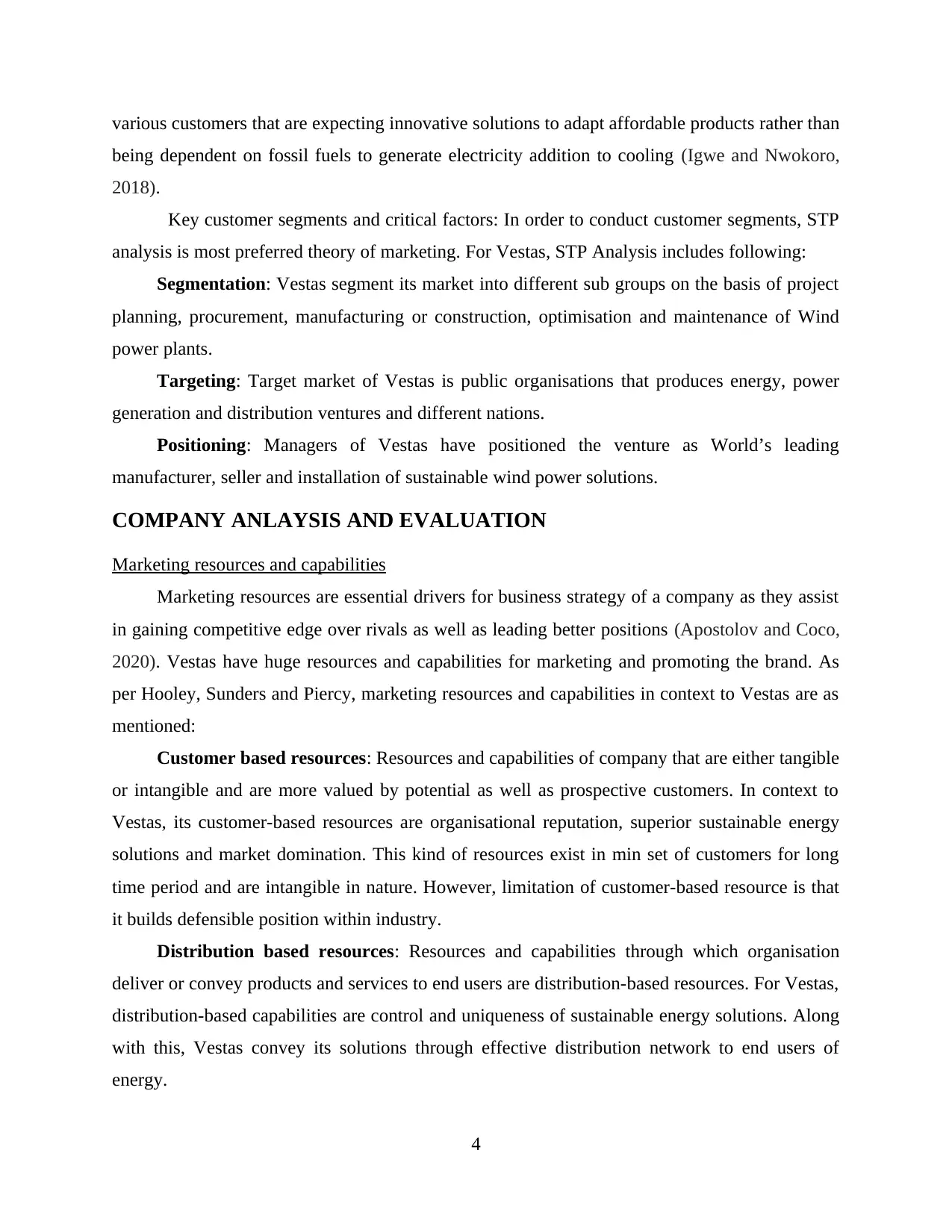
various customers that are expecting innovative solutions to adapt affordable products rather than
being dependent on fossil fuels to generate electricity addition to cooling (Igwe and Nwokoro,
2018).
Key customer segments and critical factors: In order to conduct customer segments, STP
analysis is most preferred theory of marketing. For Vestas, STP Analysis includes following:
Segmentation: Vestas segment its market into different sub groups on the basis of project
planning, procurement, manufacturing or construction, optimisation and maintenance of Wind
power plants.
Targeting: Target market of Vestas is public organisations that produces energy, power
generation and distribution ventures and different nations.
Positioning: Managers of Vestas have positioned the venture as World’s leading
manufacturer, seller and installation of sustainable wind power solutions.
COMPANY ANLAYSIS AND EVALUATION
Marketing resources and capabilities
Marketing resources are essential drivers for business strategy of a company as they assist
in gaining competitive edge over rivals as well as leading better positions (Apostolov and Coco,
2020). Vestas have huge resources and capabilities for marketing and promoting the brand. As
per Hooley, Sunders and Piercy, marketing resources and capabilities in context to Vestas are as
mentioned:
Customer based resources: Resources and capabilities of company that are either tangible
or intangible and are more valued by potential as well as prospective customers. In context to
Vestas, its customer-based resources are organisational reputation, superior sustainable energy
solutions and market domination. This kind of resources exist in min set of customers for long
time period and are intangible in nature. However, limitation of customer-based resource is that
it builds defensible position within industry.
Distribution based resources: Resources and capabilities through which organisation
deliver or convey products and services to end users are distribution-based resources. For Vestas,
distribution-based capabilities are control and uniqueness of sustainable energy solutions. Along
with this, Vestas convey its solutions through effective distribution network to end users of
energy.
4
being dependent on fossil fuels to generate electricity addition to cooling (Igwe and Nwokoro,
2018).
Key customer segments and critical factors: In order to conduct customer segments, STP
analysis is most preferred theory of marketing. For Vestas, STP Analysis includes following:
Segmentation: Vestas segment its market into different sub groups on the basis of project
planning, procurement, manufacturing or construction, optimisation and maintenance of Wind
power plants.
Targeting: Target market of Vestas is public organisations that produces energy, power
generation and distribution ventures and different nations.
Positioning: Managers of Vestas have positioned the venture as World’s leading
manufacturer, seller and installation of sustainable wind power solutions.
COMPANY ANLAYSIS AND EVALUATION
Marketing resources and capabilities
Marketing resources are essential drivers for business strategy of a company as they assist
in gaining competitive edge over rivals as well as leading better positions (Apostolov and Coco,
2020). Vestas have huge resources and capabilities for marketing and promoting the brand. As
per Hooley, Sunders and Piercy, marketing resources and capabilities in context to Vestas are as
mentioned:
Customer based resources: Resources and capabilities of company that are either tangible
or intangible and are more valued by potential as well as prospective customers. In context to
Vestas, its customer-based resources are organisational reputation, superior sustainable energy
solutions and market domination. This kind of resources exist in min set of customers for long
time period and are intangible in nature. However, limitation of customer-based resource is that
it builds defensible position within industry.
Distribution based resources: Resources and capabilities through which organisation
deliver or convey products and services to end users are distribution-based resources. For Vestas,
distribution-based capabilities are control and uniqueness of sustainable energy solutions. Along
with this, Vestas convey its solutions through effective distribution network to end users of
energy.
4
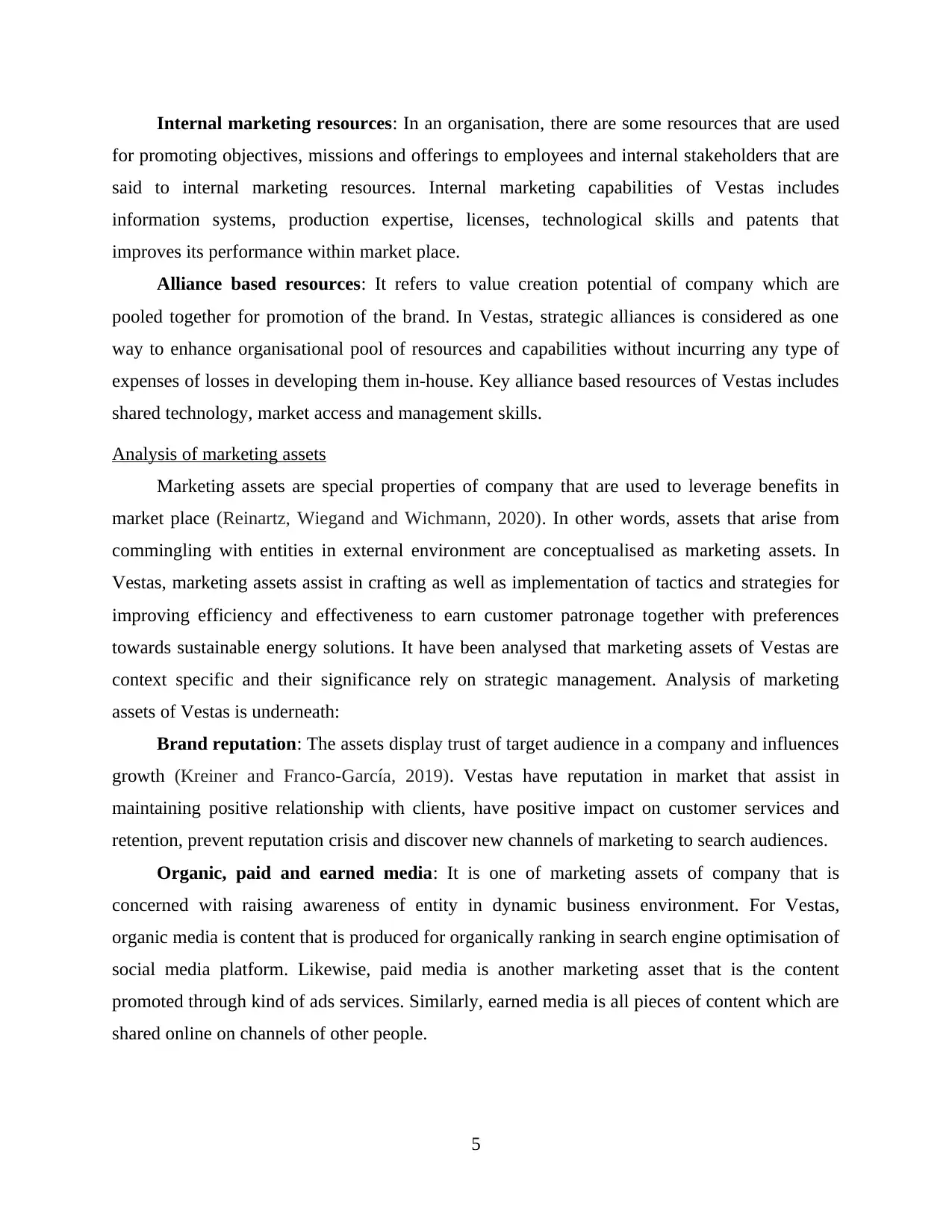
Internal marketing resources: In an organisation, there are some resources that are used
for promoting objectives, missions and offerings to employees and internal stakeholders that are
said to internal marketing resources. Internal marketing capabilities of Vestas includes
information systems, production expertise, licenses, technological skills and patents that
improves its performance within market place.
Alliance based resources: It refers to value creation potential of company which are
pooled together for promotion of the brand. In Vestas, strategic alliances is considered as one
way to enhance organisational pool of resources and capabilities without incurring any type of
expenses of losses in developing them in-house. Key alliance based resources of Vestas includes
shared technology, market access and management skills.
Analysis of marketing assets
Marketing assets are special properties of company that are used to leverage benefits in
market place (Reinartz, Wiegand and Wichmann, 2020). In other words, assets that arise from
commingling with entities in external environment are conceptualised as marketing assets. In
Vestas, marketing assets assist in crafting as well as implementation of tactics and strategies for
improving efficiency and effectiveness to earn customer patronage together with preferences
towards sustainable energy solutions. It have been analysed that marketing assets of Vestas are
context specific and their significance rely on strategic management. Analysis of marketing
assets of Vestas is underneath:
Brand reputation: The assets display trust of target audience in a company and influences
growth (Kreiner and Franco-García, 2019). Vestas have reputation in market that assist in
maintaining positive relationship with clients, have positive impact on customer services and
retention, prevent reputation crisis and discover new channels of marketing to search audiences.
Organic, paid and earned media: It is one of marketing assets of company that is
concerned with raising awareness of entity in dynamic business environment. For Vestas,
organic media is content that is produced for organically ranking in search engine optimisation of
social media platform. Likewise, paid media is another marketing asset that is the content
promoted through kind of ads services. Similarly, earned media is all pieces of content which are
shared online on channels of other people.
5
for promoting objectives, missions and offerings to employees and internal stakeholders that are
said to internal marketing resources. Internal marketing capabilities of Vestas includes
information systems, production expertise, licenses, technological skills and patents that
improves its performance within market place.
Alliance based resources: It refers to value creation potential of company which are
pooled together for promotion of the brand. In Vestas, strategic alliances is considered as one
way to enhance organisational pool of resources and capabilities without incurring any type of
expenses of losses in developing them in-house. Key alliance based resources of Vestas includes
shared technology, market access and management skills.
Analysis of marketing assets
Marketing assets are special properties of company that are used to leverage benefits in
market place (Reinartz, Wiegand and Wichmann, 2020). In other words, assets that arise from
commingling with entities in external environment are conceptualised as marketing assets. In
Vestas, marketing assets assist in crafting as well as implementation of tactics and strategies for
improving efficiency and effectiveness to earn customer patronage together with preferences
towards sustainable energy solutions. It have been analysed that marketing assets of Vestas are
context specific and their significance rely on strategic management. Analysis of marketing
assets of Vestas is underneath:
Brand reputation: The assets display trust of target audience in a company and influences
growth (Kreiner and Franco-García, 2019). Vestas have reputation in market that assist in
maintaining positive relationship with clients, have positive impact on customer services and
retention, prevent reputation crisis and discover new channels of marketing to search audiences.
Organic, paid and earned media: It is one of marketing assets of company that is
concerned with raising awareness of entity in dynamic business environment. For Vestas,
organic media is content that is produced for organically ranking in search engine optimisation of
social media platform. Likewise, paid media is another marketing asset that is the content
promoted through kind of ads services. Similarly, earned media is all pieces of content which are
shared online on channels of other people.
5
Paraphrase This Document
Need a fresh take? Get an instant paraphrase of this document with our AI Paraphraser
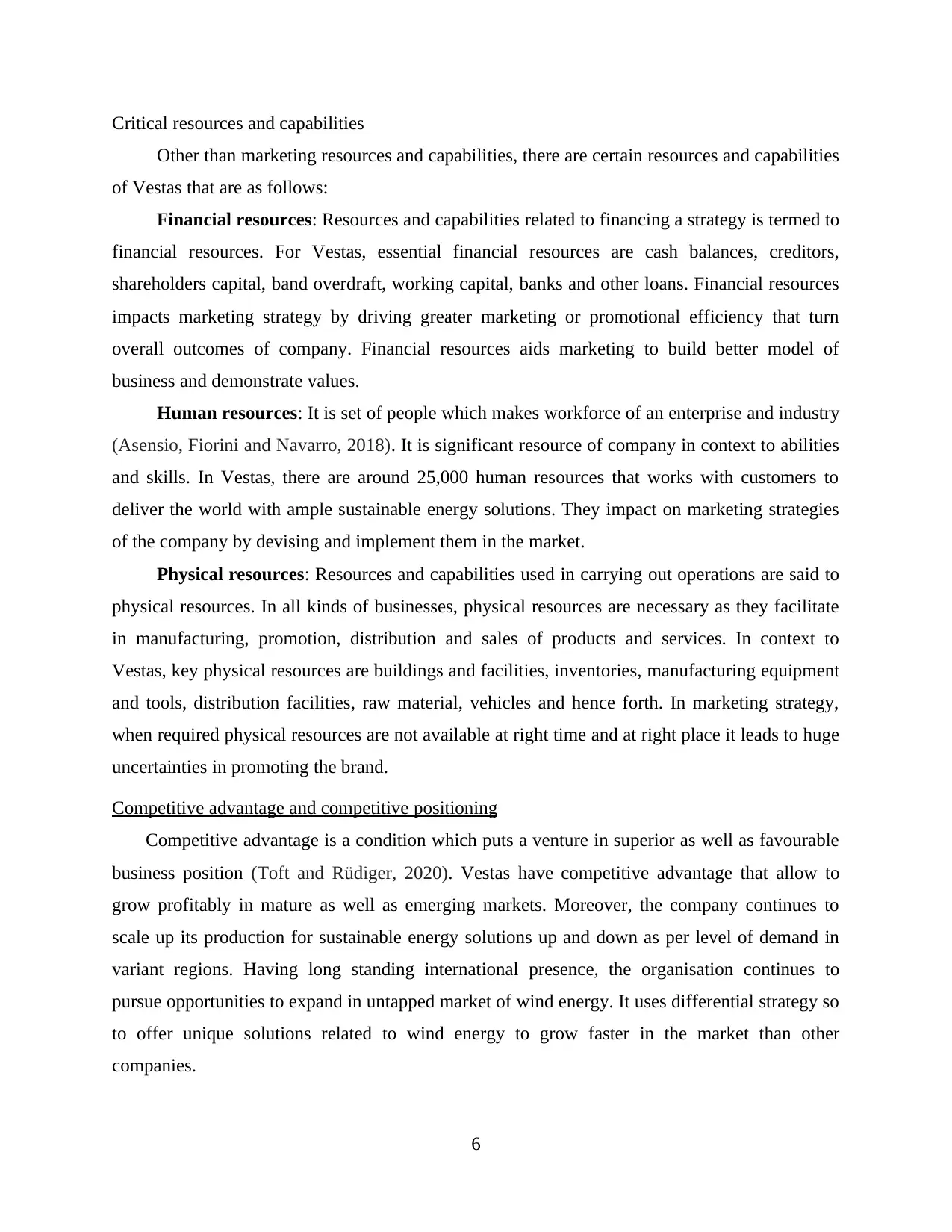
Critical resources and capabilities
Other than marketing resources and capabilities, there are certain resources and capabilities
of Vestas that are as follows:
Financial resources: Resources and capabilities related to financing a strategy is termed to
financial resources. For Vestas, essential financial resources are cash balances, creditors,
shareholders capital, band overdraft, working capital, banks and other loans. Financial resources
impacts marketing strategy by driving greater marketing or promotional efficiency that turn
overall outcomes of company. Financial resources aids marketing to build better model of
business and demonstrate values.
Human resources: It is set of people which makes workforce of an enterprise and industry
(Asensio, Fiorini and Navarro, 2018). It is significant resource of company in context to abilities
and skills. In Vestas, there are around 25,000 human resources that works with customers to
deliver the world with ample sustainable energy solutions. They impact on marketing strategies
of the company by devising and implement them in the market.
Physical resources: Resources and capabilities used in carrying out operations are said to
physical resources. In all kinds of businesses, physical resources are necessary as they facilitate
in manufacturing, promotion, distribution and sales of products and services. In context to
Vestas, key physical resources are buildings and facilities, inventories, manufacturing equipment
and tools, distribution facilities, raw material, vehicles and hence forth. In marketing strategy,
when required physical resources are not available at right time and at right place it leads to huge
uncertainties in promoting the brand.
Competitive advantage and competitive positioning
Competitive advantage is a condition which puts a venture in superior as well as favourable
business position (Toft and Rüdiger, 2020). Vestas have competitive advantage that allow to
grow profitably in mature as well as emerging markets. Moreover, the company continues to
scale up its production for sustainable energy solutions up and down as per level of demand in
variant regions. Having long standing international presence, the organisation continues to
pursue opportunities to expand in untapped market of wind energy. It uses differential strategy so
to offer unique solutions related to wind energy to grow faster in the market than other
companies.
6
Other than marketing resources and capabilities, there are certain resources and capabilities
of Vestas that are as follows:
Financial resources: Resources and capabilities related to financing a strategy is termed to
financial resources. For Vestas, essential financial resources are cash balances, creditors,
shareholders capital, band overdraft, working capital, banks and other loans. Financial resources
impacts marketing strategy by driving greater marketing or promotional efficiency that turn
overall outcomes of company. Financial resources aids marketing to build better model of
business and demonstrate values.
Human resources: It is set of people which makes workforce of an enterprise and industry
(Asensio, Fiorini and Navarro, 2018). It is significant resource of company in context to abilities
and skills. In Vestas, there are around 25,000 human resources that works with customers to
deliver the world with ample sustainable energy solutions. They impact on marketing strategies
of the company by devising and implement them in the market.
Physical resources: Resources and capabilities used in carrying out operations are said to
physical resources. In all kinds of businesses, physical resources are necessary as they facilitate
in manufacturing, promotion, distribution and sales of products and services. In context to
Vestas, key physical resources are buildings and facilities, inventories, manufacturing equipment
and tools, distribution facilities, raw material, vehicles and hence forth. In marketing strategy,
when required physical resources are not available at right time and at right place it leads to huge
uncertainties in promoting the brand.
Competitive advantage and competitive positioning
Competitive advantage is a condition which puts a venture in superior as well as favourable
business position (Toft and Rüdiger, 2020). Vestas have competitive advantage that allow to
grow profitably in mature as well as emerging markets. Moreover, the company continues to
scale up its production for sustainable energy solutions up and down as per level of demand in
variant regions. Having long standing international presence, the organisation continues to
pursue opportunities to expand in untapped market of wind energy. It uses differential strategy so
to offer unique solutions related to wind energy to grow faster in the market than other
companies.
6
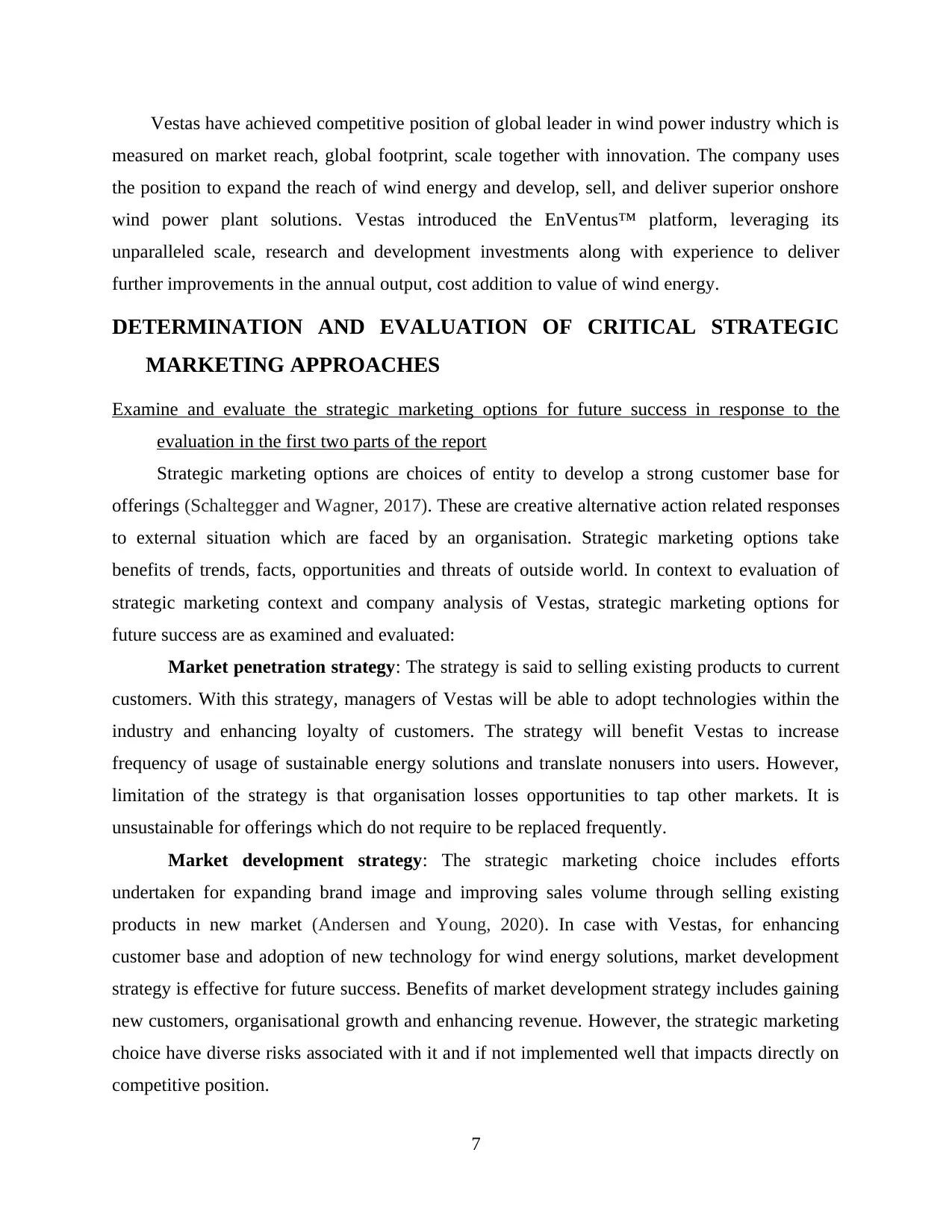
Vestas have achieved competitive position of global leader in wind power industry which is
measured on market reach, global footprint, scale together with innovation. The company uses
the position to expand the reach of wind energy and develop, sell, and deliver superior onshore
wind power plant solutions. Vestas introduced the EnVentus™ platform, leveraging its
unparalleled scale, research and development investments along with experience to deliver
further improvements in the annual output, cost addition to value of wind energy.
DETERMINATION AND EVALUATION OF CRITICAL STRATEGIC
MARKETING APPROACHES
Examine and evaluate the strategic marketing options for future success in response to the
evaluation in the first two parts of the report
Strategic marketing options are choices of entity to develop a strong customer base for
offerings (Schaltegger and Wagner, 2017). These are creative alternative action related responses
to external situation which are faced by an organisation. Strategic marketing options take
benefits of trends, facts, opportunities and threats of outside world. In context to evaluation of
strategic marketing context and company analysis of Vestas, strategic marketing options for
future success are as examined and evaluated:
Market penetration strategy: The strategy is said to selling existing products to current
customers. With this strategy, managers of Vestas will be able to adopt technologies within the
industry and enhancing loyalty of customers. The strategy will benefit Vestas to increase
frequency of usage of sustainable energy solutions and translate nonusers into users. However,
limitation of the strategy is that organisation losses opportunities to tap other markets. It is
unsustainable for offerings which do not require to be replaced frequently.
Market development strategy: The strategic marketing choice includes efforts
undertaken for expanding brand image and improving sales volume through selling existing
products in new market (Andersen and Young, 2020). In case with Vestas, for enhancing
customer base and adoption of new technology for wind energy solutions, market development
strategy is effective for future success. Benefits of market development strategy includes gaining
new customers, organisational growth and enhancing revenue. However, the strategic marketing
choice have diverse risks associated with it and if not implemented well that impacts directly on
competitive position.
7
measured on market reach, global footprint, scale together with innovation. The company uses
the position to expand the reach of wind energy and develop, sell, and deliver superior onshore
wind power plant solutions. Vestas introduced the EnVentus™ platform, leveraging its
unparalleled scale, research and development investments along with experience to deliver
further improvements in the annual output, cost addition to value of wind energy.
DETERMINATION AND EVALUATION OF CRITICAL STRATEGIC
MARKETING APPROACHES
Examine and evaluate the strategic marketing options for future success in response to the
evaluation in the first two parts of the report
Strategic marketing options are choices of entity to develop a strong customer base for
offerings (Schaltegger and Wagner, 2017). These are creative alternative action related responses
to external situation which are faced by an organisation. Strategic marketing options take
benefits of trends, facts, opportunities and threats of outside world. In context to evaluation of
strategic marketing context and company analysis of Vestas, strategic marketing options for
future success are as examined and evaluated:
Market penetration strategy: The strategy is said to selling existing products to current
customers. With this strategy, managers of Vestas will be able to adopt technologies within the
industry and enhancing loyalty of customers. The strategy will benefit Vestas to increase
frequency of usage of sustainable energy solutions and translate nonusers into users. However,
limitation of the strategy is that organisation losses opportunities to tap other markets. It is
unsustainable for offerings which do not require to be replaced frequently.
Market development strategy: The strategic marketing choice includes efforts
undertaken for expanding brand image and improving sales volume through selling existing
products in new market (Andersen and Young, 2020). In case with Vestas, for enhancing
customer base and adoption of new technology for wind energy solutions, market development
strategy is effective for future success. Benefits of market development strategy includes gaining
new customers, organisational growth and enhancing revenue. However, the strategic marketing
choice have diverse risks associated with it and if not implemented well that impacts directly on
competitive position.
7
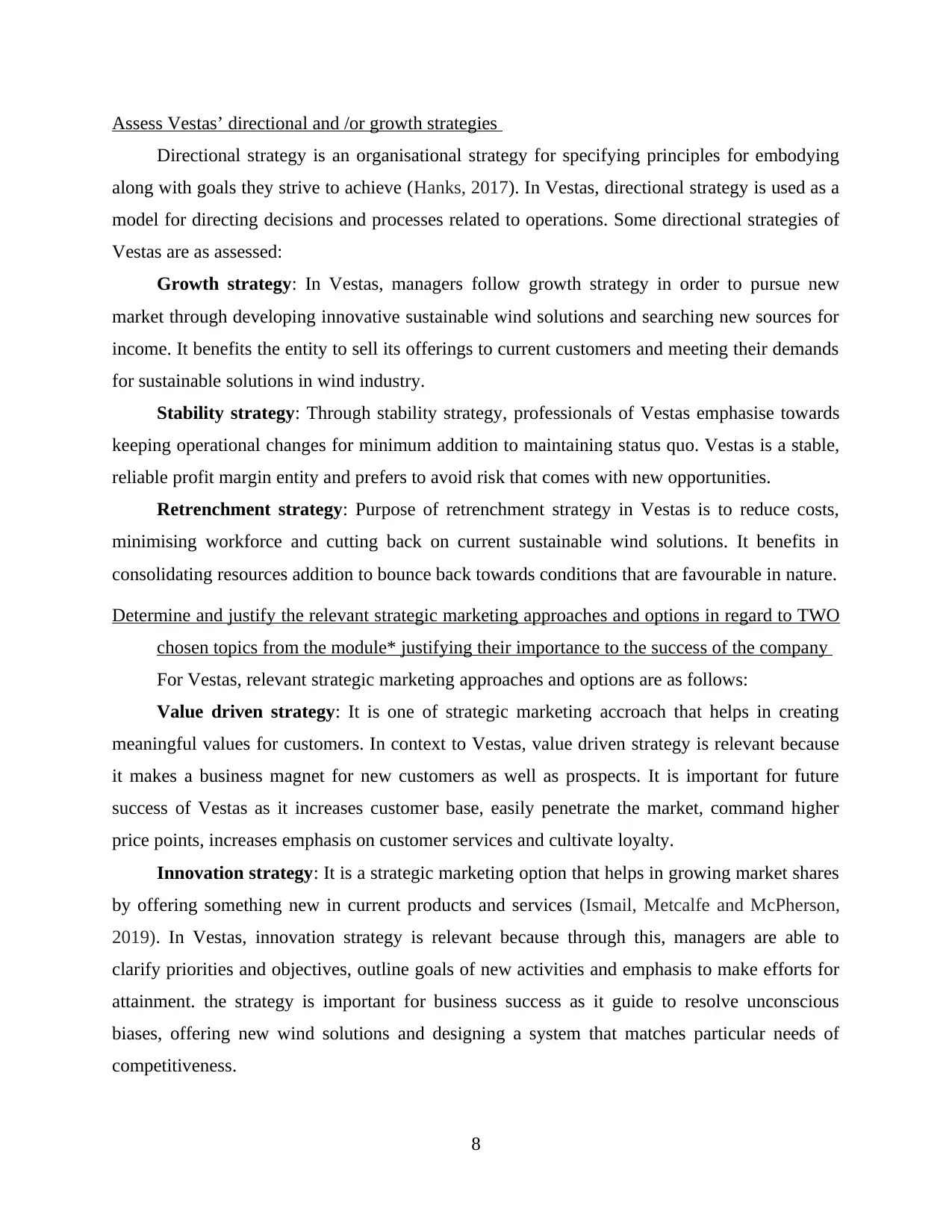
Assess Vestas’ directional and /or growth strategies
Directional strategy is an organisational strategy for specifying principles for embodying
along with goals they strive to achieve (Hanks, 2017). In Vestas, directional strategy is used as a
model for directing decisions and processes related to operations. Some directional strategies of
Vestas are as assessed:
Growth strategy: In Vestas, managers follow growth strategy in order to pursue new
market through developing innovative sustainable wind solutions and searching new sources for
income. It benefits the entity to sell its offerings to current customers and meeting their demands
for sustainable solutions in wind industry.
Stability strategy: Through stability strategy, professionals of Vestas emphasise towards
keeping operational changes for minimum addition to maintaining status quo. Vestas is a stable,
reliable profit margin entity and prefers to avoid risk that comes with new opportunities.
Retrenchment strategy: Purpose of retrenchment strategy in Vestas is to reduce costs,
minimising workforce and cutting back on current sustainable wind solutions. It benefits in
consolidating resources addition to bounce back towards conditions that are favourable in nature.
Determine and justify the relevant strategic marketing approaches and options in regard to TWO
chosen topics from the module* justifying their importance to the success of the company
For Vestas, relevant strategic marketing approaches and options are as follows:
Value driven strategy: It is one of strategic marketing accroach that helps in creating
meaningful values for customers. In context to Vestas, value driven strategy is relevant because
it makes a business magnet for new customers as well as prospects. It is important for future
success of Vestas as it increases customer base, easily penetrate the market, command higher
price points, increases emphasis on customer services and cultivate loyalty.
Innovation strategy: It is a strategic marketing option that helps in growing market shares
by offering something new in current products and services (Ismail, Metcalfe and McPherson,
2019). In Vestas, innovation strategy is relevant because through this, managers are able to
clarify priorities and objectives, outline goals of new activities and emphasis to make efforts for
attainment. the strategy is important for business success as it guide to resolve unconscious
biases, offering new wind solutions and designing a system that matches particular needs of
competitiveness.
8
Directional strategy is an organisational strategy for specifying principles for embodying
along with goals they strive to achieve (Hanks, 2017). In Vestas, directional strategy is used as a
model for directing decisions and processes related to operations. Some directional strategies of
Vestas are as assessed:
Growth strategy: In Vestas, managers follow growth strategy in order to pursue new
market through developing innovative sustainable wind solutions and searching new sources for
income. It benefits the entity to sell its offerings to current customers and meeting their demands
for sustainable solutions in wind industry.
Stability strategy: Through stability strategy, professionals of Vestas emphasise towards
keeping operational changes for minimum addition to maintaining status quo. Vestas is a stable,
reliable profit margin entity and prefers to avoid risk that comes with new opportunities.
Retrenchment strategy: Purpose of retrenchment strategy in Vestas is to reduce costs,
minimising workforce and cutting back on current sustainable wind solutions. It benefits in
consolidating resources addition to bounce back towards conditions that are favourable in nature.
Determine and justify the relevant strategic marketing approaches and options in regard to TWO
chosen topics from the module* justifying their importance to the success of the company
For Vestas, relevant strategic marketing approaches and options are as follows:
Value driven strategy: It is one of strategic marketing accroach that helps in creating
meaningful values for customers. In context to Vestas, value driven strategy is relevant because
it makes a business magnet for new customers as well as prospects. It is important for future
success of Vestas as it increases customer base, easily penetrate the market, command higher
price points, increases emphasis on customer services and cultivate loyalty.
Innovation strategy: It is a strategic marketing option that helps in growing market shares
by offering something new in current products and services (Ismail, Metcalfe and McPherson,
2019). In Vestas, innovation strategy is relevant because through this, managers are able to
clarify priorities and objectives, outline goals of new activities and emphasis to make efforts for
attainment. the strategy is important for business success as it guide to resolve unconscious
biases, offering new wind solutions and designing a system that matches particular needs of
competitiveness.
8
Secure Best Marks with AI Grader
Need help grading? Try our AI Grader for instant feedback on your assignments.
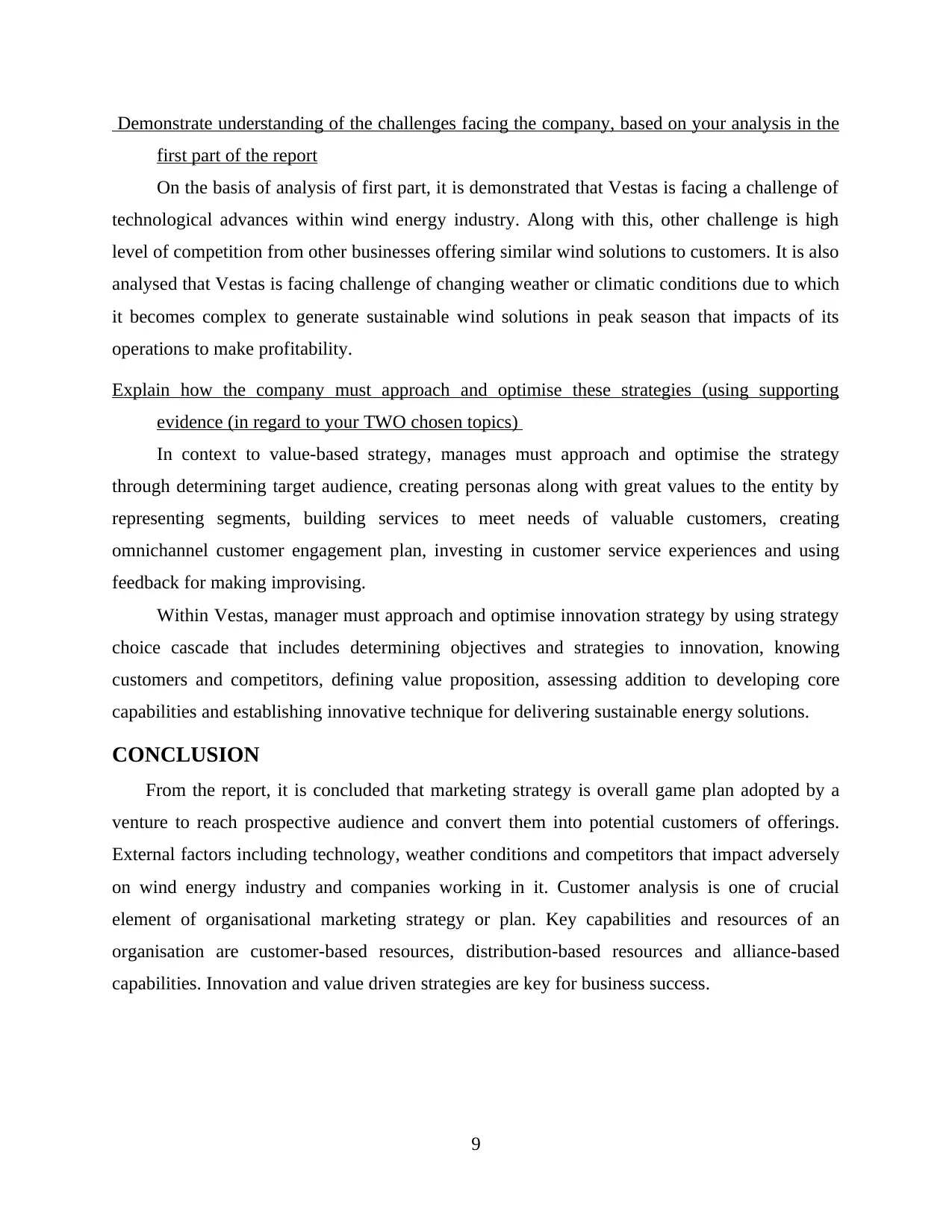
Demonstrate understanding of the challenges facing the company, based on your analysis in the
first part of the report
On the basis of analysis of first part, it is demonstrated that Vestas is facing a challenge of
technological advances within wind energy industry. Along with this, other challenge is high
level of competition from other businesses offering similar wind solutions to customers. It is also
analysed that Vestas is facing challenge of changing weather or climatic conditions due to which
it becomes complex to generate sustainable wind solutions in peak season that impacts of its
operations to make profitability.
Explain how the company must approach and optimise these strategies (using supporting
evidence (in regard to your TWO chosen topics)
In context to value-based strategy, manages must approach and optimise the strategy
through determining target audience, creating personas along with great values to the entity by
representing segments, building services to meet needs of valuable customers, creating
omnichannel customer engagement plan, investing in customer service experiences and using
feedback for making improvising.
Within Vestas, manager must approach and optimise innovation strategy by using strategy
choice cascade that includes determining objectives and strategies to innovation, knowing
customers and competitors, defining value proposition, assessing addition to developing core
capabilities and establishing innovative technique for delivering sustainable energy solutions.
CONCLUSION
From the report, it is concluded that marketing strategy is overall game plan adopted by a
venture to reach prospective audience and convert them into potential customers of offerings.
External factors including technology, weather conditions and competitors that impact adversely
on wind energy industry and companies working in it. Customer analysis is one of crucial
element of organisational marketing strategy or plan. Key capabilities and resources of an
organisation are customer-based resources, distribution-based resources and alliance-based
capabilities. Innovation and value driven strategies are key for business success.
9
first part of the report
On the basis of analysis of first part, it is demonstrated that Vestas is facing a challenge of
technological advances within wind energy industry. Along with this, other challenge is high
level of competition from other businesses offering similar wind solutions to customers. It is also
analysed that Vestas is facing challenge of changing weather or climatic conditions due to which
it becomes complex to generate sustainable wind solutions in peak season that impacts of its
operations to make profitability.
Explain how the company must approach and optimise these strategies (using supporting
evidence (in regard to your TWO chosen topics)
In context to value-based strategy, manages must approach and optimise the strategy
through determining target audience, creating personas along with great values to the entity by
representing segments, building services to meet needs of valuable customers, creating
omnichannel customer engagement plan, investing in customer service experiences and using
feedback for making improvising.
Within Vestas, manager must approach and optimise innovation strategy by using strategy
choice cascade that includes determining objectives and strategies to innovation, knowing
customers and competitors, defining value proposition, assessing addition to developing core
capabilities and establishing innovative technique for delivering sustainable energy solutions.
CONCLUSION
From the report, it is concluded that marketing strategy is overall game plan adopted by a
venture to reach prospective audience and convert them into potential customers of offerings.
External factors including technology, weather conditions and competitors that impact adversely
on wind energy industry and companies working in it. Customer analysis is one of crucial
element of organisational marketing strategy or plan. Key capabilities and resources of an
organisation are customer-based resources, distribution-based resources and alliance-based
capabilities. Innovation and value driven strategies are key for business success.
9
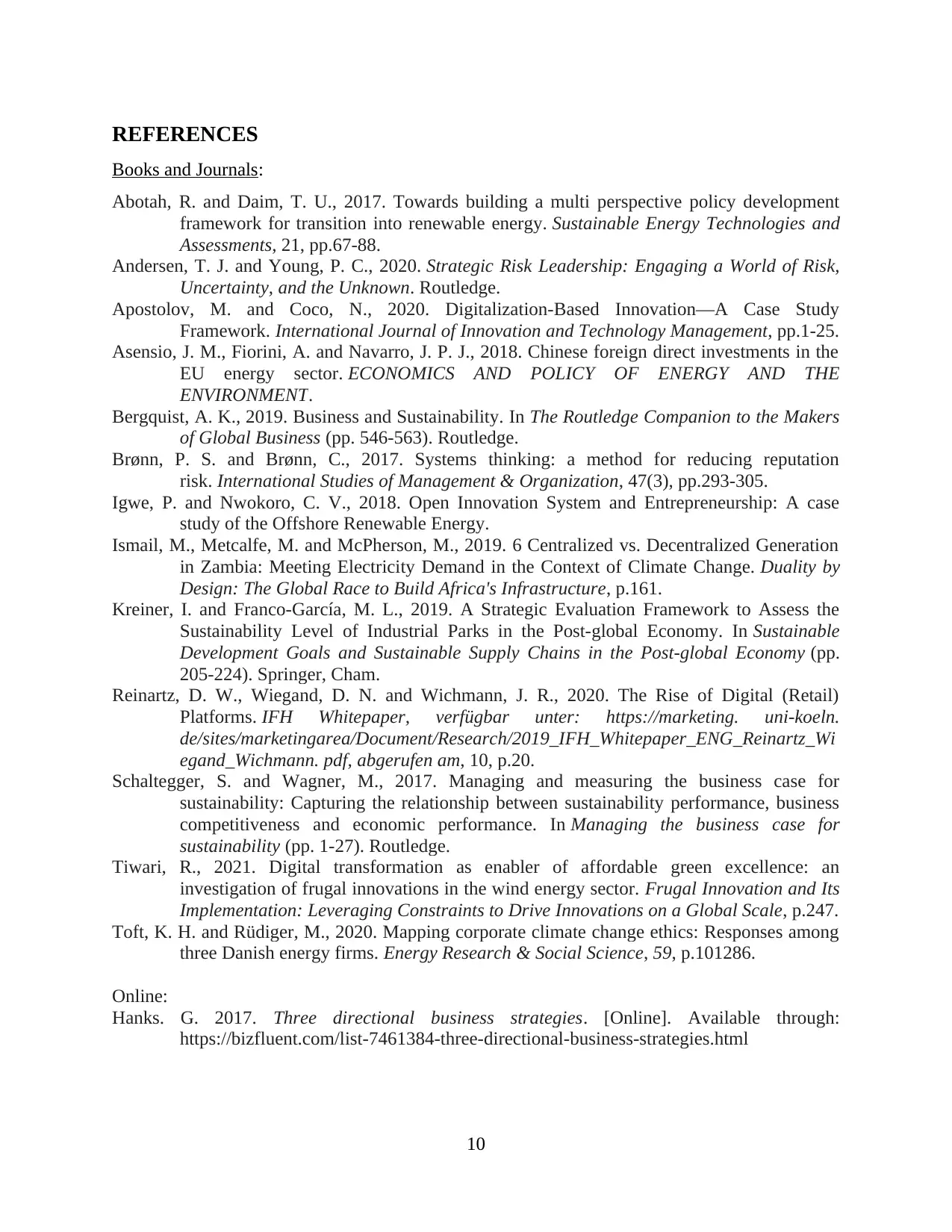
REFERENCES
Books and Journals:
Abotah, R. and Daim, T. U., 2017. Towards building a multi perspective policy development
framework for transition into renewable energy. Sustainable Energy Technologies and
Assessments, 21, pp.67-88.
Andersen, T. J. and Young, P. C., 2020. Strategic Risk Leadership: Engaging a World of Risk,
Uncertainty, and the Unknown. Routledge.
Apostolov, M. and Coco, N., 2020. Digitalization-Based Innovation—A Case Study
Framework. International Journal of Innovation and Technology Management, pp.1-25.
Asensio, J. M., Fiorini, A. and Navarro, J. P. J., 2018. Chinese foreign direct investments in the
EU energy sector. ECONOMICS AND POLICY OF ENERGY AND THE
ENVIRONMENT.
Bergquist, A. K., 2019. Business and Sustainability. In The Routledge Companion to the Makers
of Global Business (pp. 546-563). Routledge.
Brønn, P. S. and Brønn, C., 2017. Systems thinking: a method for reducing reputation
risk. International Studies of Management & Organization, 47(3), pp.293-305.
Igwe, P. and Nwokoro, C. V., 2018. Open Innovation System and Entrepreneurship: A case
study of the Offshore Renewable Energy.
Ismail, M., Metcalfe, M. and McPherson, M., 2019. 6 Centralized vs. Decentralized Generation
in Zambia: Meeting Electricity Demand in the Context of Climate Change. Duality by
Design: The Global Race to Build Africa's Infrastructure, p.161.
Kreiner, I. and Franco-García, M. L., 2019. A Strategic Evaluation Framework to Assess the
Sustainability Level of Industrial Parks in the Post-global Economy. In Sustainable
Development Goals and Sustainable Supply Chains in the Post-global Economy (pp.
205-224). Springer, Cham.
Reinartz, D. W., Wiegand, D. N. and Wichmann, J. R., 2020. The Rise of Digital (Retail)
Platforms. IFH Whitepaper, verfügbar unter: https://marketing. uni-koeln.
de/sites/marketingarea/Document/Research/2019_IFH_Whitepaper_ENG_Reinartz_Wi
egand_Wichmann. pdf, abgerufen am, 10, p.20.
Schaltegger, S. and Wagner, M., 2017. Managing and measuring the business case for
sustainability: Capturing the relationship between sustainability performance, business
competitiveness and economic performance. In Managing the business case for
sustainability (pp. 1-27). Routledge.
Tiwari, R., 2021. Digital transformation as enabler of affordable green excellence: an
investigation of frugal innovations in the wind energy sector. Frugal Innovation and Its
Implementation: Leveraging Constraints to Drive Innovations on a Global Scale, p.247.
Toft, K. H. and Rüdiger, M., 2020. Mapping corporate climate change ethics: Responses among
three Danish energy firms. Energy Research & Social Science, 59, p.101286.
Online:
Hanks. G. 2017. Three directional business strategies. [Online]. Available through:
https://bizfluent.com/list-7461384-three-directional-business-strategies.html
10
Books and Journals:
Abotah, R. and Daim, T. U., 2017. Towards building a multi perspective policy development
framework for transition into renewable energy. Sustainable Energy Technologies and
Assessments, 21, pp.67-88.
Andersen, T. J. and Young, P. C., 2020. Strategic Risk Leadership: Engaging a World of Risk,
Uncertainty, and the Unknown. Routledge.
Apostolov, M. and Coco, N., 2020. Digitalization-Based Innovation—A Case Study
Framework. International Journal of Innovation and Technology Management, pp.1-25.
Asensio, J. M., Fiorini, A. and Navarro, J. P. J., 2018. Chinese foreign direct investments in the
EU energy sector. ECONOMICS AND POLICY OF ENERGY AND THE
ENVIRONMENT.
Bergquist, A. K., 2019. Business and Sustainability. In The Routledge Companion to the Makers
of Global Business (pp. 546-563). Routledge.
Brønn, P. S. and Brønn, C., 2017. Systems thinking: a method for reducing reputation
risk. International Studies of Management & Organization, 47(3), pp.293-305.
Igwe, P. and Nwokoro, C. V., 2018. Open Innovation System and Entrepreneurship: A case
study of the Offshore Renewable Energy.
Ismail, M., Metcalfe, M. and McPherson, M., 2019. 6 Centralized vs. Decentralized Generation
in Zambia: Meeting Electricity Demand in the Context of Climate Change. Duality by
Design: The Global Race to Build Africa's Infrastructure, p.161.
Kreiner, I. and Franco-García, M. L., 2019. A Strategic Evaluation Framework to Assess the
Sustainability Level of Industrial Parks in the Post-global Economy. In Sustainable
Development Goals and Sustainable Supply Chains in the Post-global Economy (pp.
205-224). Springer, Cham.
Reinartz, D. W., Wiegand, D. N. and Wichmann, J. R., 2020. The Rise of Digital (Retail)
Platforms. IFH Whitepaper, verfügbar unter: https://marketing. uni-koeln.
de/sites/marketingarea/Document/Research/2019_IFH_Whitepaper_ENG_Reinartz_Wi
egand_Wichmann. pdf, abgerufen am, 10, p.20.
Schaltegger, S. and Wagner, M., 2017. Managing and measuring the business case for
sustainability: Capturing the relationship between sustainability performance, business
competitiveness and economic performance. In Managing the business case for
sustainability (pp. 1-27). Routledge.
Tiwari, R., 2021. Digital transformation as enabler of affordable green excellence: an
investigation of frugal innovations in the wind energy sector. Frugal Innovation and Its
Implementation: Leveraging Constraints to Drive Innovations on a Global Scale, p.247.
Toft, K. H. and Rüdiger, M., 2020. Mapping corporate climate change ethics: Responses among
three Danish energy firms. Energy Research & Social Science, 59, p.101286.
Online:
Hanks. G. 2017. Three directional business strategies. [Online]. Available through:
https://bizfluent.com/list-7461384-three-directional-business-strategies.html
10
1 out of 12
Related Documents
Your All-in-One AI-Powered Toolkit for Academic Success.
+13062052269
info@desklib.com
Available 24*7 on WhatsApp / Email
![[object Object]](/_next/static/media/star-bottom.7253800d.svg)
Unlock your academic potential
© 2024 | Zucol Services PVT LTD | All rights reserved.





